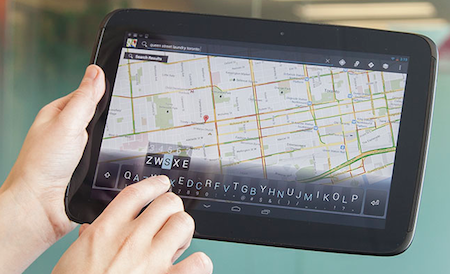
Although virtual keyboards are increasingly common, they can sometimes be frustrating to use. That frustration helps explain why the “Minuum”, a new keyboard developed by Will Walmsley (MASc IndE 1T2) and computer science assistant professor Khai Truong, is creating a lot of buzz lately.
Described as the “the little keyboard for big fingers,” Minuum is squeezed on to the screen’s edge, enabling quick and precise typing from one row of keys. Current smartphones and tablets use a standard keyboard touchscreen, but this touch-type approach can be error-prone and the keyboard often covers most screen space, Walmsley said.
The Minuum has both a cleaner design and more accuracy than other virtual keyboards, he said. “What distinguishes Minuum from other touchscreen keyboards is that it takes up less space. Users of smartphones know that keyboards can take up to half or up to 80 per cent of their screen. If you’re sending an email or text message, you often can’t see anything of what has been sent previously; it’s a frustration that people have. Minuum satisfies their craving for more screen space.”

Walmsley and Truong began their research during a course project on human and computer interaction in Walmsley’s first year of graduate studies. They started by looking at alternate ways to text, for example, just by selecting letters by tilting the phone. With the Minuum, the researchers’ specialized auto-correction algorithm translates in real-time the difference between what is typed and what is meant, and corrects it even when a letter is missed.
“It’s very simple, and lends itself to new ways of typing,” says Walmsley, who as CEO of Whirlscape is devoting full time to Minuum. “The way we’re currently developing Minuum is to continually tap on letters. We’ve designed the keyboard based on the common QWERTY keyboard, to make it immediately usable.”
According to Whirlscape’s website, “Current technology assumes that sticking a full typewriter into a touchscreen device is the best way to enter text, giving us keyboards that are error-prone and cover up half the usable screen space (or more) on most smartphones and tablets. Minuum, on the other hand, eliminates the visual clutter of archaic mobile keyboards by adapting the keyboard to a single dimension. What enables this minimalism is our specialized auto-correction algorithm that allows highly imprecise typing. This algorithm interprets in real time the difference between what you type and what you mean, getting it right even if you miss every single letter.”
Walmsley and Truong plan to commercialize an Android version of the Minuum keyboard shortly. Other applications are expected to follow.
They received support from UTEST, the University of Toronto Early Stage Technology. UTEST accepts companies in the very earliest stages of idea generation – before they’re ready for traditional incubators – and awards each company up to $30,000 in start-up funds. UTEST is jointly administered by the Innovations & Partnerships Office at the University of Toronto and MaRS Innovation.
Top tech blogs Techcrunch.com, Mobilesyrup and iClarified, among others, are already buzzing about Minuum. The researchers have recently launched an Indiegogo campaign to raise awareness and additional funds to support the ongoing development of the project. In less than 10 hours after the campaign launch on March 18, they reached 33% of their crowd funding goal.
To learn more, visit http://minuum.com/



